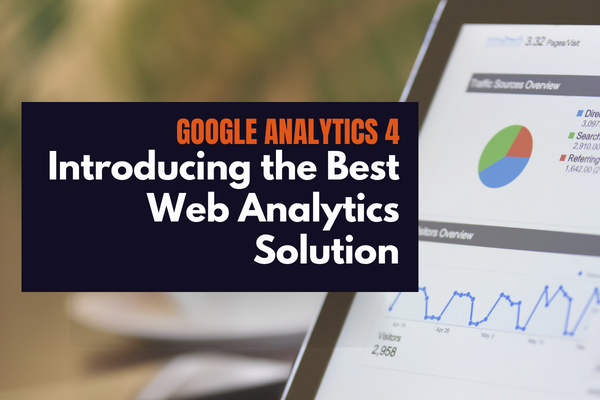BOOKKEEPING ARTICLES AND RESOURCES

Google Analytics 4: Introducing the Best Web Analytics Solution
Google Analytics 4 is a web analytics solution that allows you to track traffic and activity on your websites and applications. This documentation contains implementation guidelines and references aimed at developers. Continue reading to learn more.
Definition
This is an upgrade from Google's widely used data collecting and analysis software to assist businesses with a virtual presence.
It is intended to address some of the most important issues influencing Search Engine Optimization, like evolving user privacy regulations and the increased usage of smartphone applications.
Benefits Of Using Google Analytics 4
The software uses machine learning and predictive analytics to fill any data gaps. This gives organizations greater insight into customer behavior is one of the major advantages of upgrading to Google Analytics 4.
Additionally, Google Analytics 4 attributes offer better insight into the client lifecycle by integrating web and mobile application tracking.
New capabilities in this analytics include personalizing events and quickly integrating cross-domain measurement without manually editing a website's code.
What's New?
Cross-channel Data-driven attribution
The cross-channel data-driven attribution model (DDA) is accessible in the Advertiser Workspace's Attribution reports (Conversion Paths and Model Comparison).
In Admin > Attribution Settings, the property-level Reporting Attribution Model (RAM) choice includes DDA and all rules-based attribution models.
Users can change this parameter with the Editor role. It applies to any report that may employ event-scoped traffic dimensions (Campaign, Source, Medium) in the Total Conversions, Total Revenue, Total Ad Revenue, and Purchase Revenue metrics:
Report on Conversion Details (Reports > Engagement > Conversions > Select conversion for more information)
Investigate (Create an exploration and select an event-scoped dimension and any relevant metrics)
Integration With Display & Video 360
Linking Google Analytics 4 properties to Display & Video 360 advertisers. The following functionalities are supported by Connecting to Display & Video 360:
In Google Analytics 4 cross-channel reporting, users will receive attributed Display & Video 360 traffic. Additionally, Google Analytics 4 audiences that are eligible will be exported to Display & Video 360 for campaign targeting.
You will be able to send conversions from Google Analytics 4 to Display & Video 360 for use in Custom Bidding algorithms.
GBRAID and WBRAID Support
More granular campaign statistics will be accessible for GBRAID and WBRAID inside Google Analytics 4 starting in early March 2022.
New Predict Top Spenders Template In Explorations > Template Gallery
Marketers are always assessing which marketing platforms would assist them in attracting high-spending clients. On the other hand, predicting the future can take a long time and be technically difficult. This problem can be solved using GA4 Predictive Metrics and the User Lifetime approach in Explorations.
Google has published a Predict top spenders template in Explorations' Template Gallery. This template makes these strong predictive indicators easier to find and takes the uncertainty out of how to apply them in Explorations.
Conclusion
Other new features and integrations include ID permissions, Autosuggest, Amended APPI, sub-properties roll-up properties, and many more, which you can find here on the Analytics support page by Google.

Google Analytics 4: Introducing the Best Web Analytics Solution
Google Analytics 4 is a web analytics solution that allows you to track traffic and activity on your websites and applications. This documentation contains implementation guidelines and references aimed at developers. Continue reading to learn more.
Definition
This is an upgrade from Google's widely used data collecting and analysis software to assist businesses with a virtual presence.
It is intended to address some of the most important issues influencing Search Engine Optimization, like evolving user privacy regulations and the increased usage of smartphone applications.
Benefits Of Using Google Analytics 4
The software uses machine learning and predictive analytics to fill any data gaps. This gives organizations greater insight into customer behavior is one of the major advantages of upgrading to Google Analytics 4.
Additionally, Google Analytics 4 attributes offer better insight into the client lifecycle by integrating web and mobile application tracking.
New capabilities in this analytics include personalizing events and quickly integrating cross-domain measurement without manually editing a website's code.
What's New?
Cross-channel Data-driven attribution
The cross-channel data-driven attribution model (DDA) is accessible in the Advertiser Workspace's Attribution reports (Conversion Paths and Model Comparison).
In Admin > Attribution Settings, the property-level Reporting Attribution Model (RAM) choice includes DDA and all rules-based attribution models.
Users can change this parameter with the Editor role. It applies to any report that may employ event-scoped traffic dimensions (Campaign, Source, Medium) in the Total Conversions, Total Revenue, Total Ad Revenue, and Purchase Revenue metrics:
Report on Conversion Details (Reports > Engagement > Conversions > Select conversion for more information)
Investigate (Create an exploration and select an event-scoped dimension and any relevant metrics)
Integration With Display & Video 360
Linking Google Analytics 4 properties to Display & Video 360 advertisers. The following functionalities are supported by Connecting to Display & Video 360:
In Google Analytics 4 cross-channel reporting, users will receive attributed Display & Video 360 traffic. Additionally, Google Analytics 4 audiences that are eligible will be exported to Display & Video 360 for campaign targeting.
You will be able to send conversions from Google Analytics 4 to Display & Video 360 for use in Custom Bidding algorithms.
GBRAID and WBRAID Support
More granular campaign statistics will be accessible for GBRAID and WBRAID inside Google Analytics 4 starting in early March 2022.
New Predict Top Spenders Template In Explorations > Template Gallery
Marketers are always assessing which marketing platforms would assist them in attracting high-spending clients. On the other hand, predicting the future can take a long time and be technically difficult. This problem can be solved using GA4 Predictive Metrics and the User Lifetime approach in Explorations.
Google has published a Predict top spenders template in Explorations' Template Gallery. This template makes these strong predictive indicators easier to find and takes the uncertainty out of how to apply them in Explorations.
Conclusion
Other new features and integrations include ID permissions, Autosuggest, Amended APPI, sub-properties roll-up properties, and many more, which you can find here on the Analytics support page by Google.

Quick Links
Why Choose Us
How does it work
Pricing
Social Media Links
© 2024 – Bottcher Group of Companies
All Right Reserved



